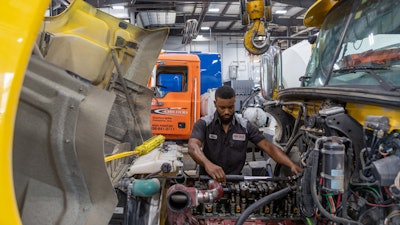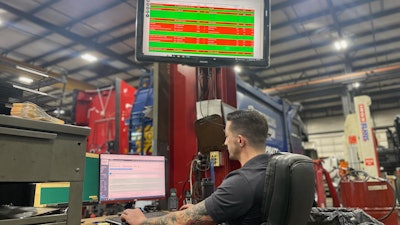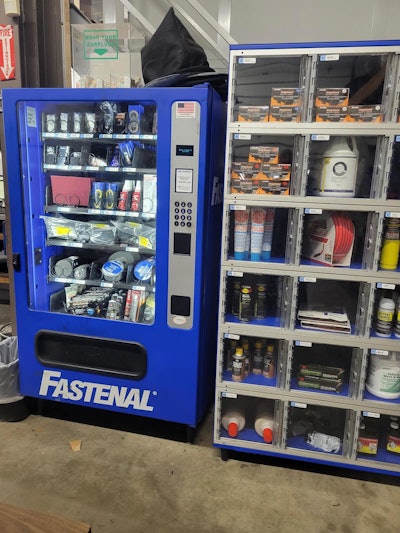
Nothing is more frustrating to a fleet than having a repair held up because the parts to fix it are not available. And nothing is more frustrating to a technician than requesting parts from the parts department only to have the wrong one picked.
Of course, getting the right part is, to some degree, dependent on what’s in inventory, but that is only a portion of the story. The other key to getting the right parts for a repair is the communication and collaboration between the technician and the parts department. If not handled properly, this causes friction between personnel, slows down repairs and wastes a great deal of technician time.
Mark Wasilko, vice president of marketing at Decisiv, explains that industry lore says technicians only spend 30% of their time turning wrenches. The other 70% is spent doing other things — including trying to get the parts needed to complete a repair.
According to the experts Trucks, Parts, Service spoke with, getting the technician the right part starts the moment the truck hits the service bay for its initial diagnosis. Once a diagnosis is made and the root cause of the failure identified, the shop should begin building a repair order (RO), and that repair order should include a list of the parts that are needed for the repair.
[RELATED: Tactics to improve your customer's parts purchasing experience]
With Decisiv’s platform, once the fleet approves the repair, a copy of the RO is sent to the parts department and Wasilko explains that parts personnel can then go pick parts and let the service department know which parts are in stock, which need to be ordered and when those parts not in stock will arrive at the shop.
 A shop foreman is a vital associate within a service garage because they are often the only person aware of the all the jobs in progress and can keep an eye on parts requests to ensure technicians don't have to stop working.
A shop foreman is a vital associate within a service garage because they are often the only person aware of the all the jobs in progress and can keep an eye on parts requests to ensure technicians don't have to stop working.
Using a service repair management system eliminates the back and forth between the technician and the parts department. There are no questions about the parts spec because the platform maintains an accurate list of the vehicle’s specifications, or whether all the co-components are included because the RO contains all the details of exactly what is needed.
“The RO is written by the tech, reviewed by the service writer, but is shared digitally with the parts department,” Wasilko says. “Basically, you have eliminated much of the inefficiency in traditional back and forth interaction between the bay and the parts department.”
[RELATED: Don't become a dinosaur. Independent shops must be ready to evolve with vehicle technology]
One best practice Wasilko has seen at truck dealerships is co-locating parts in the service bay. In other words, some parts — especially those needed for recurring or repetitive repair work — are kept in the shop’s bays.
Kevin Bowers, director of service operations at Transource, set up what he calls a command post in his dealership’s shops. “At a minimum, it is staffed by a shop foreman and a parts clerk,” he says. “The parts clerks just work with the shop. They do not answer over-the-counter calls. Their primary job is to help the technicians.”
If a technician needs a part, “he workflows that to the shop foreman and the parts person in the command center,” Bowers explains. If it is a warranty part, it gets pulled and delivered to the bay. “If it is something small like zip ties that we may have overlooked on the original quote, we just have the parts guy bring it out to the bay,” Bowers says.
However, prior to that, during the diagnostic phase of the repair, Transource techs determine what repair is needed, develop a quote for the cost of the repair including parts and labor and send that quote to the parts department so they are aware of what parts are going to be needed. Similar to the best practice Decisiv suggests, after the repair is approved, the parts are pulled and brought out to the bay.
“We used to have a back parts counter that basically became a meeting point,” Bowers says. “We had one parts person trying to meet the needs of five or six techs, so of course there was a lot of time spent waiting for parts. Moving to our current system has eliminated that problem.”
Bowers adds Transource’s shop efficiency has increased by 38% in the decade since the change was made.
Gill Klinger, professional advisor at KEA Advisors, says the key to efficiency in the service department is keeping the technicians in their bays working on trucks. KEA’s advice for improving the relationship between the parts department and service department is to triage all repairs to determine the root cause of the problem, and, once that is done, to back the truck out of the shop. “We suggest it stay parked until two things are provided,” he says. “The first is authorization for the repair and the second is having the part pulled and staged in a certain location depending on the space availability at the shop.”
Klinger is a big believer in what he terms, “slowing down to speed up.” He explains it this way: “If we take our time when we build the estimate and then keep it live so the estimate matches the repair order, throughout the whole repair process we can speed up and close the RO on the backside more quickly and efficiently.”
He says having the parts and service departments work closely together benefits the shop. “For every dollar that is sold in labor, there is approximately a dollar’s worth of parts sold. So, it is in the best interest of the parts department to work with the service department because there is a 99.5% chance that the service department is the number one customer of the parts department.”
[RELATED: HD Repair Forum session tackles shop culture and its impact on tech retention]
Ed Chipalowsky, vehicle service and support manager for the North American Council for Freight Efficiency (NACFE) and a former technician and former diesel technology instructor, explains the shop is controlled by the service manager.
“If they have a good relationship with their parts departments and their techs, they are going to put emphasis on both parts and service to work together for the benefit of the company,” he says.
A case for AR in the service department
Getting the right part for a repair is a complicated process exacerbated by the fact there is a choice between OE parts, aftermarket parts, all-makes parts, private label parts and more. Yet it is extremely important the technician get the exact right part to complete a repair properly. Having access to the VIN is a good way to ensure the exact part is identified. But not all service providers have access to the VIN data.
Chipalowsky believes augmented reality (AR) brought into the shop can lead to better parts identification.
“Technicians can use AR to send photos of the component in place, the ID plate on the component, the serial number, the truck model number, etc.,” he says. He believes this could speed up the repair process and ensure more accuracy in identifying the parts needed for a repair.
 Dedicating space in a shop where common supplies can be easily accessed is another way to reduce technician downtime because the associate never has to hunt to find a tool they need.
Dedicating space in a shop where common supplies can be easily accessed is another way to reduce technician downtime because the associate never has to hunt to find a tool they need.
Warranty parts and cores
Warranty parts and cores can be a challenge for a shop. Klinger suggests shops dedicate space in each bay for placing parts that need to be returned as part of a warranty claim and a spot for cores.
“It is the technician’s job to tag and record the part, take a picture of it and then let the parts department know it is ready to be picked up,” he says. A dedicated person from the parts department can then go pick up the parts so the technician does not have to go to the parts counter with them.
“Once the parts person knows the parts are ready, they can go pick them up the next time they go out to the shop,” he adds. Some shops set specific times for parts runners to make their rounds of picking of cores and warranty parts but, in either case, assigning someone to handle this task keeps the technicians in the bays where they are making money for the shop.









